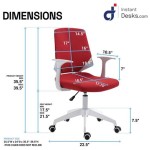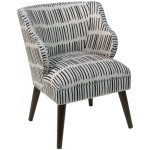Ergonomic Chairs With Lumbar Support: A Comprehensive Guide
In today's work environment, where prolonged periods of sitting are common, maintaining proper posture and supporting the spine is paramount for health and well-being. Ergonomic chairs with lumbar support have emerged as essential tools for promoting comfort, preventing back pain, and enhancing productivity. These chairs are meticulously designed to align the body in a neutral position, reducing stress on the spine, and supporting the natural curvature of the lower back.
The human spine is a complex structure, composed of vertebrae, intervertebral discs, and ligaments. The lumbar region, or lower back, is particularly vulnerable to strain and injury due to its role in supporting the upper body weight and facilitating movement. Poor posture, inadequate seating, and prolonged sitting can contribute to excessive pressure on the lumbar discs, leading to pain, discomfort, and potential long-term health problems. Ergonomic chairs with lumbar support address these issues by providing targeted support to the lower back, encouraging proper spinal alignment, and distributing weight more evenly.
Understanding the Importance of Lumbar Support
The primary purpose of lumbar support in an ergonomic chair is to maintain the natural inward curve of the lower back. This curvature, known as lordosis, is essential for proper spinal alignment and weight distribution. Without adequate support, the lumbar region tends to flatten or even curve outward, placing undue stress on the discs and surrounding muscles. This can lead to a variety of issues, including lower back pain, muscle fatigue, and even nerve compression.
Ergonomic chairs with lumbar support typically feature a contoured backrest that conforms to the shape of the lower back. This contour provides gentle but firm support, encouraging the spine to maintain its natural curve. Some chairs also offer adjustable lumbar support, allowing users to customize the level of support to their individual needs and preferences. This adjustability is particularly important, as body types and spinal curves vary considerably from person to person.
By providing targeted support to the lumbar region, ergonomic chairs can help to alleviate existing back pain, prevent future injuries, and improve overall comfort. When the spine is properly aligned, the muscles and ligaments surrounding it can relax, reducing tension and fatigue. This, in turn, can lead to increased focus, productivity, and overall well-being.
Key Features to Look for in Ergonomic Chairs With Lumbar Support
When selecting an ergonomic chair with lumbar support, it is crucial to consider several key features to ensure optimal comfort and support. These features include the adjustability of the lumbar support, the overall design of the backrest, the materials used in construction, and the chair's ability to be customized to individual needs.
Adjustable Lumbar Support: As mentioned earlier, adjustable lumbar support is a critical feature. Ideally, the chair should allow users to adjust both the height and depth of the lumbar support to achieve the perfect fit. This ensures that the support is positioned correctly to target the specific area of the lower back that needs it most. Some chairs offer a simple knob or lever adjustment, while others feature more sophisticated pneumatic or ratchet systems.
Backrest Design: The overall design of the backrest is also important. The backrest should be contoured to follow the natural curves of the spine, providing support not only to the lumbar region but also to the mid and upper back. The height of the backrest should also be adjustable to accommodate users of different heights. A taller backrest offers more support to the upper back and shoulders, while a shorter backrest may be more suitable for individuals who prefer greater freedom of movement.
Material Quality: The materials used in the construction of the chair also play a significant role in its comfort and durability. Breathable mesh fabrics are often used for the backrest to promote airflow and prevent overheating. High-density foam is typically used for the seat cushion to provide comfortable support for extended periods. The base of the chair should be sturdy and stable, with smooth-rolling casters that allow for easy movement.
Adjustability: Beyond lumbar support, look for adjustability in other areas of the chair. A chair with adjustable armrests, seat height, seat depth and tilt is important. Some chairs also offer adjustability in the backrest angle and the amount of tension in the tilt mechanism. These adjustments allow users to fine-tune the chair to their individual needs and preferences, ensuring a comfortable and supportive seating experience.
The Benefits of Investing in Ergonomic Seating
Investing in ergonomic chairs with lumbar support is a worthwhile investment in employee health, productivity, and overall well-being. While the initial cost may be higher than that of a standard office chair, the long-term benefits far outweigh the expense. These benefits include reduced back pain and discomfort, improved posture, increased productivity, and a decrease in workplace injuries.
Reduced Back Pain and Discomfort: By providing targeted support to the lumbar region and promoting proper spinal alignment, ergonomic chairs can significantly reduce back pain and discomfort. This can lead to improved mood, increased energy levels, and a greater ability to focus on work tasks.
Improved Posture: Ergonomic chairs encourage users to maintain proper posture, which can have a positive impact on overall health and well-being. Good posture reduces stress on the spine, improves circulation, and can even boost confidence. Over time, consistently using an ergonomic chair can help to retrain the body to maintain proper posture even when not seated.
Increased Productivity: When employees are comfortable and free from pain, they are more likely to be productive. Ergonomic chairs can help to improve focus, concentration, and overall work performance. By reducing distractions caused by discomfort, ergonomic chairs allow employees to dedicate their attention to the task at hand.
Decrease in Workplace Injuries: Musculoskeletal disorders (MSDs), including back pain, are a leading cause of workplace injuries. Ergonomic chairs can help to prevent these injuries by reducing the risk factors associated with prolonged sitting and poor posture. By investing in ergonomic seating, employers can create a safer and healthier work environment for their employees.
Long-Term Health Benefits: Beyond the immediate benefits of comfort and productivity, ergonomic chairs can contribute to long-term health and well-being. By preventing back pain and promoting proper posture, these chairs can help to reduce the risk of chronic spinal problems and other related health issues. This can lead to a higher quality of life and a greater ability to participate in physical activities.
In conclusion, ergonomic chairs with lumbar support are essential tools for promoting health, comfort, and productivity in today's work environment. By understanding the importance of lumbar support, considering the key features of ergonomic chairs, and recognizing the numerous benefits of investing in ergonomic seating, individuals and organizations can make informed decisions that lead to a healthier and more productive future.
It is important to note that while ergonomic chairs are beneficial, they are not a complete solution for preventing back pain and promoting overall health. Regular breaks, stretching exercises, and proper workstation setup are also crucial components of a comprehensive ergonomic program. Consulting with a healthcare professional or an ergonomics specialist can provide personalized guidance on selecting the right chair and implementing best practices for workplace ergonomics.
The market offers numerous ergonomic chairs with varying features and price points. Researching different models, reading reviews, and trying out chairs in person, when possible, can help to ensure that the selected chair meets individual needs and preferences. A well-chosen ergonomic chair can be a long-term investment in health, comfort, and productivity, making it a valuable asset for any individual or organization.

Alpha Home Ergonomic Fabric Mid Back Office Task Chair With Lumbar Support Black

Costway Mesh Adaptive Lumbar Support Ergonomic Office Chair In Black With Adjustable Arms Hcst01502

Verte Chair Best Ergonomic Lumbar Support Me

Leisuremod Adjustable Office Chair Ergonomic Mesh Back Computer Lumbar Support With Armrest Dale Series In Light Grey Do56lgr The Home

Office Chair Ergonomic Desk With Adjustable Height And Lumbar Support

Alivio Ergonomic High Back Office Chair With Headrest Lumbar Support Flip Up Armrest

Big And Tall Office Chair 500lbs With 3d Rolling Massage Lumbar Cushion Executive High Back Reclining Footrest Wide

Vevor Reclining Office Chair With Footrest Heavy Duty Pu Leather Wide Big And Tall Executive Chairs Lumbar Support Strong

Lacoo Office Gray Mid Back Swivel Lumbar Support Desk Computer Ergonomic Mesh Chair With Armrest T Ocnc7504

Westholme High Back Office Chair Ergonomic Desk Tilt Function Lumbar Support Fabric Foam Seat Gray








